Today Current Affairs: 18th September 2021 for UPSC IAS exams, State PSC exams, SSC CGL, State SSC, RRB, Railways, Banking Exam & IBPS, etc
Table of Contents
White-Sided Dolphins:
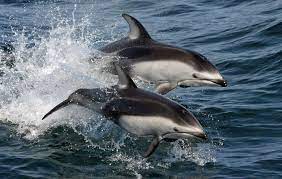
The traditional annual killing of whales and dolphins (grindadrap hunt) in North Atlantic islands that belong to Denmark has sparked controversy.
- 1,428 white-sided dolphins were slaughtered at Faroe Islands.
White-Sided Dolphins:
- Scientific Name: Lagenorhynchus acutus
- Their common name comes from the prominent white stripes on their sides, which span from below the dorsal fin to their tail, where it turns into a yellow or amber color.
- Their scientific name comes from the Greek word lagenos (which means bottle), rhynchus (which means snout or nose), and acutus from Latin (which means sharp or pointed, referring to their sharply-pointed dorsal fins).
- Habitat: The distribution of the Atlantic white-sided dolphin is the cool temperate and subarctic waters of the north Atlantic Ocean from southern Greenland to Massachusetts, and from the British Isles to western Norway.
- It has also been reported as far as the southern Barents Sea, the Baltic Sea, the Azores, and the Adriatic Sea.
- Conservation Status:
- IUCN: Least Concern
- CITES: Appendix II
Mura-Drava-Danube (MDD) Was Declared As The World’s First ‘Five-Country Biosphere Reserve:
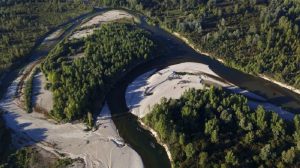
Mura-Drava-Danube (MDD) was declared as the world’s first ‘five-country biosphere reserve’ by the United Nations Educational, Scientific and Cultural Organization (UNESCO)
- The biosphere reserve covers 700 kilometres of the Mura, Drava and Danube rivers and stretches across Austria, Slovenia, Croatia, Hungary and Serbia.
- The total area of the reserve is a million hectares – in the so-called ‘Amazon of Europe’, which is now the largest riverine protected area in Europe.
- The biosphere “represented an important contribution to the European Green Deal (climate action plan) and contributed to the implementation of the EU Biodiversity Strategy in the Mura-Drava-Danube region.”
- The strategy’s aim is to revitalise 25,000 km of rivers and protect 30% of the European Union’s land area by 2030.
- The area is one of the richest in Europe in terms of species diversity.
- It is home to floodplain forests, gravel and sand banks, river islands, oxbows and meadows.
- The area is home to the highest density in Europe of breeding pairs of white-tailed eagle and endangered species such as the little tern, black stork, otters, beavers and sturgeons.
- It is also an important stepping stone for more than 2,50,000 migratory waterfowls every year.
Biosphere Reserve (BR)
- BR is an international designation by (UNESCO) for representative parts of natural and cultural landscapes extending over large areas of terrestrial or coastal/marine ecosystems or a combination of both.
- BR tries to balance economic and social development and maintenance of associated cultural values along with the preservation of nature.
- BRs are nominated by national governments and remain under the sovereign jurisdiction of the states where they are located.
- These are designated under the intergovernmental MAB Programme by the Director-General of UNESCO following the decisions of the MAB International Coordinating Council (MAB ICC).
- The Man and the Biosphere (MAB) Programme is an intergovernmental scientific programme that aims to establish a scientific basis for enhancing the relationship between people and their environments.
- Their status is internationally recognized.
- There are 727 biosphere reserves in 131 countries, including 22 transboundary sites.
- Three Main Zones:
- Core Areas: It comprises a strictly protected zone that contributes to the conservation of landscapes, ecosystems, species and genetic variation.
- Buffer Zones: It surrounds or adjoins the core area(s), and is used for activities compatible with sound ecological practices that can reinforce scientific research, monitoring, training and education.
- Transition Area: The transition area is where communities foster socio-culturally and ecologically sustainable economic and human activities.
- Biosphere Reserves in India:
- Presently, there are 18 Biosphere Reserves in India, among which 12 Biosphere reserves in India find their place in UNESCO’s List of Man & Biosphere Reserves Programme.
15th East Asia Summit Energy Ministers Meeting:
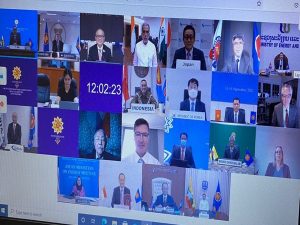
The Union Minister of State for Power attended the 15th East Asia Summit Energy Ministers Meeting.
- The theme of the meeting was “We Care, We Prepare, We Prosper”.
- The meeting was aimed at coordinating efforts of Association of Southeast Asian Nations (ASEAN) countries in pursuing the goal of energy security and energy transition that will benefit the people of the region.
- India confirmed that ASEAN is a region of great importance and engagement with ASEAN has been, and will remain, a critical element of India’s ‘Act East’ policy and strategy.
- Acting East is now a central element in India’s Indo-Pacific vision.
- A brief status of the Indian energy transition plans, policies, challenges and efforts towards decarbonisation was also provided.
- Some of India’s initiatives include National Solar Mission (NSM), Pradhan Mantri Ujjwala Yojana (PMUY), Unnat Jyoti by Affordable LEDs for All (UJALA), Smart City Mission (SCM), etc
East Asia Summit:
- Established in 2005, it is a forum of 18 regional leaders for strategic dialogue and cooperation on the key political, security, and economic challenges facing the Indo-Pacific region.
- The concept of an East Asia Grouping was first promoted in 1991 by the then Malaysian Prime Minister, Mahathir bin Mohamad.
- There are six priority areas of regional cooperation within the framework of the EAS. These are – Environment and Energy, Education, Finance, Global Health Issues and Pandemic Diseases, Natural Disaster Management, and ASEAN Connectivity.
- Membership: It comprises the ten member states of the ASEAN which are Brunei, Cambodia, Indonesia, Laos, Malaysia, Myanmar, the Philippines, Singapore, Thailand, and Vietnam, along with 8 other countries namely Australia, China, Japan, India, New Zealand, the Republic of Korea, Russia and the USA.
- It is an ASEAN-centred forum so it can only be chaired by an ASEAN member.
- Brunei Darussalam is the chair for 2021.
United In Science 2021: WMO:

The World Meteorological Organization (WMO) released a report named United in Science 2021.
- It is a multi-organization high-level compilation of the latest climate science information.
- The report is coordinated by the WMO, with inputs from the United Nations Environment Programme, World Health Organization, Intergovernmental Panel on Climate Change, Global Carbon Project, World Climate Research Programme and the Met Office (UK).
- The pace of climate change has not been slowed by the global Covid-19 pandemic and the world remains behind in its battle to cut carbon emissions.
- It has caused only a temporary downturn in carbon dioxide (CO2) emissions in 2020.
- High latitude regions and the Sahel are likely to be wetter over 2021–2025, than the recent past.
- Reduction targets are not being met and there is a rising likelihood the world will miss its Paris Agreement target of reducing global warming to 1.5 degrees Celsius above pre-industrial levels.
- There is an increasing likelihood that temperatures would temporarily breach the threshold of 1.5 degrees Celsius above the pre-industrial era, in the next five years.
- Average global temperature for the past five years was among the highest on record.
- Rising global temperatures are fuelling devastating extreme weather throughout the world, with spiralling impacts on economies and societies.
- Climate hazards such as heatwaves, wildfires and poor air quality combine to threaten human health worldwide, putting vulnerable populations at particular risk.
- Concentrations of major greenhouse gases in the atmosphere continued to increase last year and during the first half of 2021.
- Fossil fuel emissions from coal, gas, cement, etc were back to 2019 levels or even higher in 2021.
- Global mean sea levels rose 20 cm from 1900 to 2018. Even if emissions are reduced to limit warming to well below 2°C, global mean sea level would likely rise by 0.3-0.6 m by 2100, and could rise 0.3-3.1 m by 2300.
- An excess of 103 billion potential work hours were lost globally in 2019, compared to 2000.
- It was due to heat-related mortality and work impairment, caused by rising temperatures.
Crime In India Report 2020: NCRB:

National Crime Records Bureau (NCRB) released the Crime in India Report 2020.
- While 2020, a year marked by months of a national lockdown due to the pandemic saw fewer traditional crimes such as those committed against women and children, among others, it witnessed a big spike in civil conflicts.
- Riots (Civil Conflicts):
- Communal riots registered an increase of 96% in 2020 over the previous year.
- Delhi Police alone registered the highest i.e. 520 cases of communal riots in the year and Uttar Pradesh (UP) did not record a single case of communal violence in 2020.
- Caste riots saw an increase of close to 50%, agrarian riots 38% and riots during ‘andolan/morcha’ increased by 33%.
- Traditional Crimes:
- The number of cases registered for crimes against women, children and senior citizens, theft, burglary, robbery and dacoity, among others, dropped by about 2 lakh.
- Murder registered a marginal increase of 1% even as offences falling under the category of “violent crimes” decreased by 0.5%.
- Delhi is the most unsafe city for women. More than 10,093 cases of crimes against women were registered in the capital in 2020.
- Environment Related Offences:
- Cases under the ‘environment-related offences’ category increased by 78.1% in the country in 2020.
- Cyber Crime:
- The rate of cyber crime (incidents per lakh population) also increased from 3.3% in 2019 to 3.7% in 2020.
- Offences Against State:
- The year also saw a significant drop in cases related to Offences against the State, with a drop of 27% over 2019.
- UP, however, was the only major state to record an increase in this category, mostly due to the large number of ‘Damage to Public Property’ cases registered by the state, many of them during the anti- CAA (Citizenship (Amendment) Act, 2019) protests.
- Offences against the State’ include cases related to sedition and waging war against the nation, those falling under provisions of the Unlawful Activities Prevention Act (UAPA) 1967, Official Secrets Act 1923 and Damage to Public Property Act 1954.
New Bad Bank Structure:

The Union Cabinet approved the Rs 30,600 crore guarantee to back Security Receipts issued by National Asset Reconstruction Company Limited (NARCL) for acquiring stressed loan assets.
- The NARCL is a part of a new Bad bank structure that was announced in the Budget 2021.
About the New Bad Bank Structure:
- For resolution of huge NPAs (Non-Performing Assets) in the Indian Banking sector, the government of India has set up two new entities to acquire stressed assets from banks and then sell them in the market.
- NPA refers to a classification for loans or advances that are in default or in arrears.
- NARCL: NARCL has been incorporated under the Companies Act and has applied to the Reserve Bank of India for a license as an Asset Reconstruction Company (ARC).
- NARCL will acquire stressed assets worth about Rs 2 lakh crore from various commercial banks in different phases.
- Public Sector Banks (PSBs) will maintain 51% ownership in NARCL.
- IDRCL: Another entity, India Debt Resolution Company Ltd (IDRCL), will then try to sell the stressed assets in the market.
- PSBs and Public Financial Institutes (FIs) will hold a maximum of 49% stake in IDRCL. The remaining 51% stake will be with private-sector lenders.
- The NARCL-IDRCL structure is the new bad bank structure.
Bad Bank:
- The bad bank is an Asset Reconstruction Company (ARC) or an Asset Management Company (AMC) that takes over the bad loans of commercial banks, manages them and finally recovers the money over a period of time.
- The bad bank is not involved in lending and taking deposits, but helps commercial banks clean up their balance sheets and resolve bad loans.
- The takeover of bad loans is normally below the book value of the loan and the bad bank tries to recover as much as possible subsequently.
AUKUS Alliance:
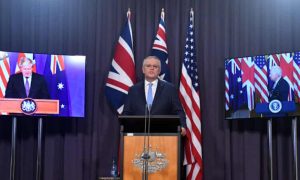
The UK, US and Australia have announced a historic security pact in the Asia-Pacific, in what’s seen as an effort to counter China. It is called the AUKUS pact and AUKUS alliance.
- Under the AUKUS alliance, the three nations have agreed to enhance the development of joint capabilities and technology sharing, foster deeper integration of security and defence-related science, technology, industrial bases and supply chains.
- Under the first major initiative of AUKUS, Australia would build a fleet of nuclear-powered submarines with the help of the US and the UK, a capability aimed at promoting stability in the Indo-Pacific region.
China’s response:
- China has condemned the agreement as “extremely irresponsible”.
- Concerns raised by China:
- The Alliance undermines regional peace and stability and intensifies the arms race.
- It shall reinvent a “Cold War mentality and ideological prejudice”.
- Rationale behind the formation of this alliance:
- The new partnership was announced in a joint virtual press conference. And while China was not mentioned directly, the three leaders referred repeatedly to regional security concerns which they said had “grown significantly”.
- In recent years, Beijing has been accused of raising tensions in disputed territories such as the South China Sea.
- Western nations have been wary of China’s infrastructure investment on Pacific islands, and have also criticised China’s trade sanctions against countries like Australia.
- These submarines are much faster and harder to detect than conventionally powered fleets. They can stay submerged for months, shoot missiles longer distances and also carry more.
- Having them stationed in Australia is critical to US influence in the region, analysts say.
- The US is sharing its submarine technology for the first time in 50 years. It had previously only shared technology with the UK.
- Australia will become just the seventh nation in the world to operate nuclear-powered submarines, after the US, UK, France, China, India and Russia.
- Australia has reaffirmed it has no intention of obtaining nuclear weapons.
What Is Collective Security Treaty Organization?
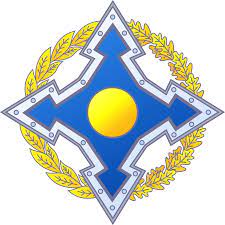
The Collective Security Treaty Organisation (CSTO) is planning to hold large military drills in Tajikistan next month, amid what it described as a deteriorating situation in neighbouring Afghanistan.
- Tajikistan is the only country out of the six-member bloc led by Russia that shares a border with Afghanistan.
- Moscow has moved to cement its position as a key player in the region after the United States’ hasty retreat from Afghanistan and the Taliban’s takeover of the country.
- The group also said it has taken “collective measures” to ensure Tajikistan’s security in case of an “aggravation” on its border with Afghanistan.
About Collective Security Treaty Organization:
- It is an intergovernmental military alliance (six countries) that came into effect in 2002.
- Its’ origin can be traced to the Collective Security Treaty, 1992 (Tashkent Treaty).
- The headquarter is located in the Russian capital of Moscow.
- The objectives of the CSTO is to strengthen peace, international and regional security including cybersecurity and stability, the protection on a collective basis of the independence, territorial integrity and sovereignty of the member states.
Composition:
- Current CSTO members are Armenia, Belarus, Kazakhstan, Kyrgyzstan, the Russian Federation and Tajikistan.
- Afghanistan and Serbia hold observer status in the CSTO.
World Bank Group Has Decided To Discontinue Publication Of Its ‘Doing Business’ Rankings Of country:

The World Bank Group has decided to discontinue publication of its ‘Doing Business’ rankings of country business climates after a review of data irregularities in the 2018 and 2020 reports.
- In August 2020, World Bank paused the publication of Doing Business reports following a number of irregularities were reported regarding changes to the data.
- The irregularities in Doing Business reports had affected four countries: China; Saudi Arabia; United Arab Emirates; and Azerbaijan.
- A probe of data irregularities cited “undue pressure” by top bank officials, including then-Chief Executive Kristalina Georgieva, to boost China’s ranking in 2017.
- This raised ethical matters involving former bank staff and board officials.
- World Bank’s annual report matters to several nations, especially developing ones, since it greatly influenced investor decisions by releasing a ranking of economies based on how easy it is to open up, and operate, a business.
- But while the report was hugely popular among investors, it was heavily criticized by many governments for its methodology that, leaders said, inaccurately captured the realities on the ground.
About Doing Business project:
- It provides objective measures of business regulations and their enforcement across 190 economies and selected cities at the subnational and regional level.
- Launched in 2003, looks at domestic small and medium-size companies and measures the regulations applying to them through their life cycle.
- It ranks countries on the basis of Distance to Frontier (DTF) score that highlights the gap of an economy with respect to the global best practice.
National Financial Reporting Authority (NFRA):

National Financial Reporting Authority (NFRA) Chairperson has pitched for a ‘standalone legislation’ for the regulator in the interests of autonomy.
- He also demanded that all necessary penal provisions relating to financial reporting should be consolidated and vested with it.
- Currently, the NFRA may take action against auditors for professional misconduct but when it came to other functionaries of a company who have the responsibility for financial reporting, penal powers continue to be vested with the Centre.
- A standalone legislation will allow for integrated regulation of all participants in the financial reporting system.
- National Financial Reporting Authority (NFRA) was constituted on 1st October, 2018 under section 132 (1) of the Companies Act, 2013.
- In the wake of accounting scams, a need was felt to establish an independent regulator for enforcement of auditing standards and ensuring the quality of audits so as to enhance investor and public confidence in financial disclosures of companies.
Composition:
- The Companies Act requires the NFRA to have a chairperson who will be appointed by the Central Government and a maximum of 15 members.




